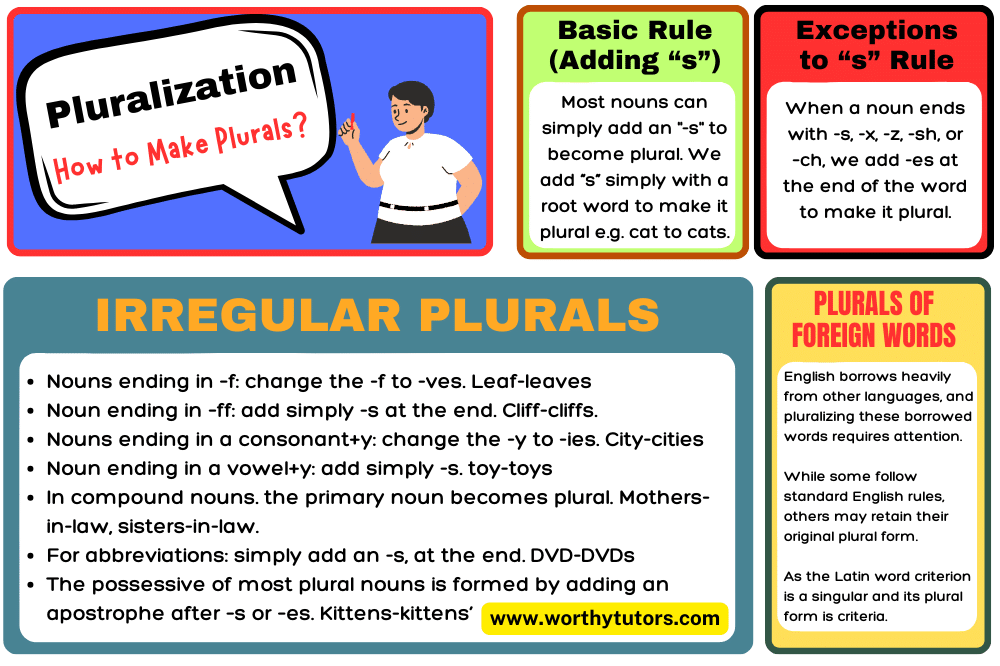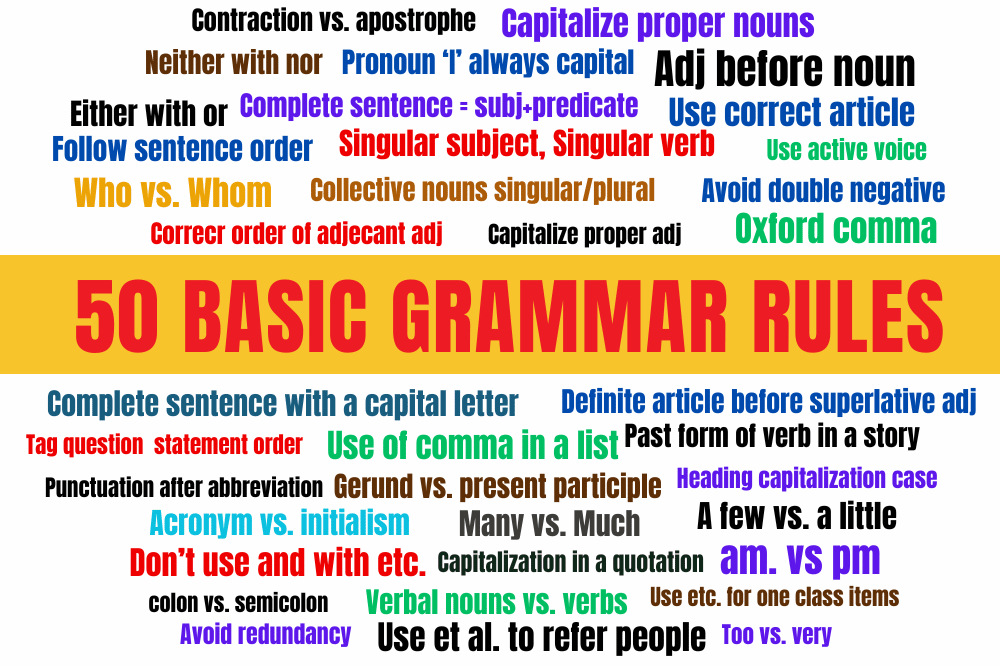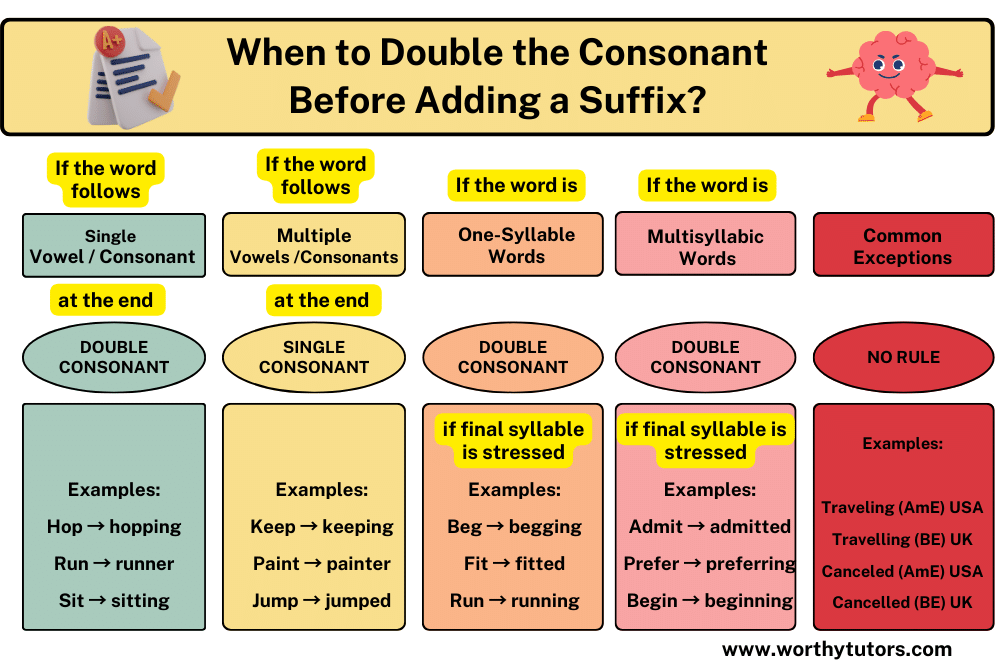
How to Make Plurals in English | Rules for Making Plurals
Effective communication in English relies heavily on proper grammar, and one crucial aspect is making plurals correctly. Whether you’re a native speaker or learning English as a second language, understanding the rules for making plurals is essential. In this article, we’ll guide you how you can make plurals, basic pluralization rules, exceptions, and practical tips.
Introduction to Pluralization
The word plural is used for two or more noun/pronoun. When there is a one noun, we say it single, and when it increases in number, we say it plural. See below examples:
- I cooked one potato. (Potato-single)
- I cooked two potatoes. (Potatoes-plural)
Pluralization is more than just adding an “-s” or “es” to the end of a word. It’s about clarity and precision in language. Correct plurals ensure that your message is conveyed accurately, avoiding any potential confusion.
Basic Plural Rules (Adding “s”)
Let’s start with the basic pluralization rules. Most nouns can simply add an “-s” to become plural. It is the basic practice to make plurals. We add “s” simply with a root word to make it plural e.g. cat to cats.
Exceptions to “s” Rule (Adding “es”)
However, exceptions exist to basic “s” rule, particularly with words ending in -s, -x, -z, -sh, and -ch. When a noun ends with -s, -x, -z, -sh, or –ch we add es at the end of the word to make it plural. Below are the few examples:
- Bus-buses
- Box-boxes
- Buzz-buzzes
- Lash-lashes
- Watch-watches
Pluralizing Words Ending in -f
When dealing with nouns ending in -f, the general rule is to change the -f to -ves. For instance, “leaf” becomes “leaves” and “calf” becomes “calves.”
Exception to Rule –f to -ves
When a noun ends with -ff, the general –f rule is not applied but we add simply -s at the end of the word. For example, the word cliff to cliffs.
Pluralizing Words Ending in Consonant + y
When dealing with nouns ending in a consonant + y, the general rule is to change the -y to -ies. For instance, “city” becomes “cities” and “baby” becomes “babies.”
Pluralizing Words Ending in Vowel + y
If the noun ends in a vowel + y, the plural is formed by simply adding -s. For example, “toy” becomes “toys” and “day” becomes “days.”
Pluralizing Compound Nouns
Compound nouns, consisting of two or more words, follow specific rules for pluralization. Typically, the primary noun receives the plural form. For instance, “mother-in-law” becomes “mothers-in-law.”
Plurals of Numbers and Letters
Numbers and letters present a unique challenge. When pluralizing numbers, an apostrophe and an -s are added, while letters only need an -s. For example, “7” becomes “7s,” and “A” becomes “As.”
Plurals of Foreign Words
English borrows heavily from other languages, and pluralizing these borrowed words requires attention. While some follow standard English rules, others may retain their original plural form. As the Latin word criterion is a singular, and its plural form is criteria. We use it in English language but we will make its plural according to its origin.
Pluralizing Abbreviations
Abbreviations, though shortened forms of words, have specific rules for pluralization. Simply add an -s, at the end. For example, “DVDs” and “CDs.”
Plural Possessives
When it comes to possessives in the plural form, things get nuanced. Understanding when to add an apostrophe and where is crucial for conveying the right meaning. Plural possessives indicate when there is more than one of a noun and show ownership of that noun as well. The possessive of most plural nouns is formed by adding an apostrophe after –s or –es. Look at the example:
John had two cars (plural). When he was running, the cars’ (possessive plural) keys were lost.
Irregular Plurals
English, being the language it is, has its fair share of irregular plurals. Words like “child” becoming “children” and “ox” becoming “oxen” don’t follow the standard rules. Familiarizing yourself with these irregularities is crucial.
Common Mistakes to Avoid While Making Plurals
In the learning process, certain mistakes are common. Be cautious with words like “octopus” (plural: “octopuses” or “octopi”) and “cactus” (plural: “cacti” or “cactuses”). Understanding these pitfalls improves your overall proficiency.
Practical Tips for Learning Plurals
- Practice Regularly: Engage in exercises and activities focused on pluralization.
- Read Widely: Exposure to well-written content helps internalize correct plural forms.
- Use Language Apps: Leverage technology for interactive learning experiences.
- Seek Feedback: Request feedback on your writing to identify and correct errors.
- Create Flashcards: Reinforce your memory with visual aids for different plural forms.
Conclusion
Knowing the rules for making plurals in English contributes significantly to effective communication. From basic rules to handling irregularities, each aspect plays a vital role in expressing ideas accurately. Remember, precision in language is a valuable skill that enhances your overall language proficiency. Hope you have learned pluralization rules.
Stay learned! Stay Confident!


